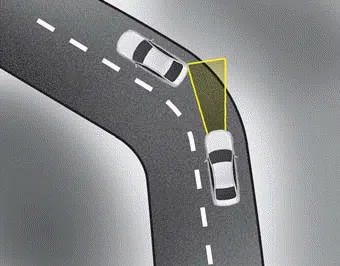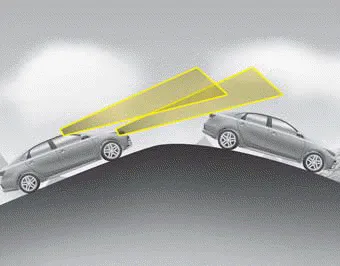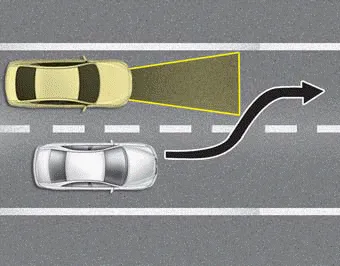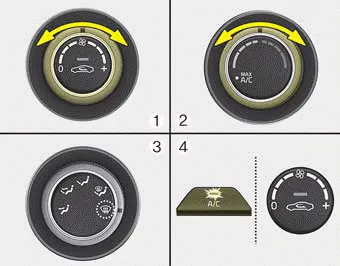Kia Forte: Forward Collision-avoidance Assist (FCA) (Camera + Radar type) / Limitation of the system
The FCA system is designed to monitor the vehicle ahead through radar signals and camera recognition to warn the driver that a collision is imminent, and if necessary, apply emergency braking. In certain situations, the radar sensor or the camera may not be able to detect the vehicle ahead. In these cases, the FCA system may not operate. The driver must pay careful attention in the following situations where the FCA operation may be limited:
Recognizing vehicles
- The radar or the camera is contaminated
with foreign substances.
- It heavily rains or snows.
- There is electromagnetic interference
- Something in the path of travel
deflects the radar waves
- The vehicle in front has a narrow
body. (i.e. motorcycles and bicycles)
- The driver’s view is not clear due to
backlight, reflected light, or darkness.
- The camera cannot contain the full
image of the vehicle in front.
- The vehicle in front is a special
vehicle, such as a heavily-loaded
truck or a trailer.
- The outside brightness is greatly
changed, such as entering/exiting
a tunnel.
- The vehicle driving is unstable.
- The radar/camera sensor recognition
is limited.
- The driver's field of view is not well
illuminated (either too dark, too
much reflection, or too much backlight
that obscures the field of view)
- There is severe irregular reflection
from the radar sensor
- The vehicle in front is driving erratically
- The vehicle is driven near areas
containing metal substances such
as a construction zone, railroad,
etc.
- Backlight is reflected in the direction
of the vehicle (including front
light from the vehicle ahead)
- Moisture on the windshield is not
completely removed or is frozen.
- The weather is misty.
- The vehicle in front does not turn
ON the rear lights, does not have
rear lights, has asymmetric rear
lights, or has rear lights out of
angle.

- Driving on a curve
The FCA performance may be limited while driving on a curve. The FCA may not recognize the vehicle in front even if in the same lane. It may produce the warning message and the warning alarm prematurely, or it may not produce the warning message or the warning alarm at all. When driving on a curve, exercise caution, maintain a safe braking distance, and if necessary, depress the brake pedal to reduce your driving speed in order to maintain a safe distance.

The FCA system may recognize a vehicle in an adjacent lane when driving on a curved road. In this situation, the system may apply the brake. Always pay attention to road and driving conditions while driving. If necessary, depress the brake pedal to reduce your driving speed in order to maintain a safe distance. Also, when necessary, you may depress the accelerator pedal to prevent the system from unnecessarily decelerating your vehicle. Always check the traffic conditions around the vehicle.

- Driving on a slope
The FCA performance may be limited while driving upward or downward on a slope, and may not recognize a vehicle in front in the same lane. It may produce the warning message and the warning alarm prematurely, or it may not produce the warning message and the warning alarm at all.
When the FCA suddenly recognizes the vehicle in front while passing over a slope, you may experience sharp deceleration.
Always keep your eyes forward while driving upward or downward on a slope, and, if necessary, depress the brake pedal.

- Changing lanes
When a vehicle changes lanes in front of you, the FCA system may not immediately detect the vehicle, especially if the vehicle changes lanes abruptly. In this situation, you must maintain a safe braking distance, and if necessary, depress the brake pedal to reduce your driving speed in order to maintain a safe distance.

When driving in stop-and-go traffic, and a stopped vehicle in front of you merges out of the lane, the FCA system may not immediately detect the new vehicle that is now in front of you. In this situation, you must maintain a safe braking distance, and if necessary, depress the brake pedal to reduce your driving speed in order to maintain a safe distance.

- Recognizing the vehicle
If the vehicle in front of you has cargo that extends rearward from the cab, or when the vehicle in front of you has higher ground clearance, additional special attention is required. The FCA system may not be able to recognize the cargo extending from the vehicle. In these instances, you must maintain a safe braking distance from the rearmost object, and if necessary, depress the brake pedal to reduce your driving
When the FCA is not working properly, the FCA warning light ( ) will illuminate and the warning message will appear for a few seconds. After the message disappears, the master warning light ( ) will illuminate.
- The pedestrian is not fully detected by the camera sensor, or the pedestrian is not walking in the upright position. - The pedestrian moves very fast.
Other information:
Kia Forte 2019-2024 (BD) Owner's Manual: Notes on the safe use of the Tire Mobility Kit
Park your car at the side of the road so that you can work with the Tire Mobility Kit away from moving traffic. To be sure your vehicle will not move, even when you're on fairly level ground, always set your parking brake. Only use the Tire Mobility Kit for sealing/inflation passenger car tires.
Kia Forte 2019-2024 (BD) Owner's Manual: Engine coolant
The high-pressure cooling system has a reservoir filled with year round antifreeze coolant. The reservoir is filled at the factory. Check the antifreeze protection and coolant level at least once a year: at the beginning of the winter season, and before traveling to a colder climate.
Categories
- Manuals Home
- Kia Forte Owners Manual
- Light bulbs
- Engine compartment
- Brake/clutch fluid
- New on site
- Most important about car
